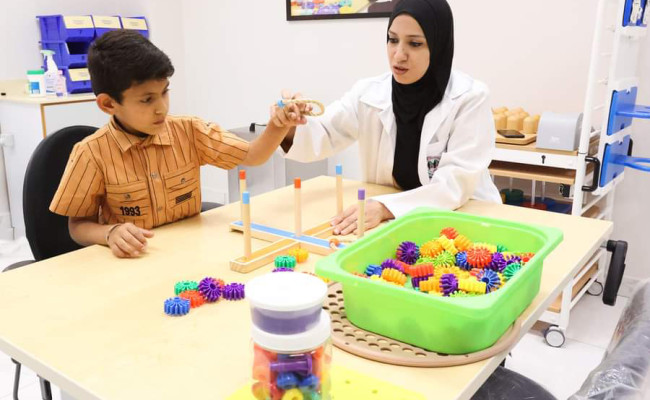Comprehensive Exam Track: Total Credit Hours Required to Finish the Degree ( 42 Credit Hours ) as Follows
Specialization Requirements
Students must pass all of the following courses
|
Course Number |
Course Name |
Weekly Hours |
Cr. Hrs. |
Prerequisite |
||
|---|---|---|---|---|---|---|
|
Theoretical |
Practical |
|||||
| 151086000 | RESEARCH METHODS AND HEALTH CARE STATISTICS | The course examines the role of research in health care and provides an overview of commonly used qualitative and quantitative research methods. Topics covered include evaluation methodologies including the research process, study design, methods of data collection, statistical analysis of data including the use of statistical packages, presentation of results, basic statistical principles, indices, databases, registries, vital statistics, descriptive statistics, research protocol monitoring and knowledge-based research techniques used in the evaluation of health care statistics. | 3 | - | 3 |
- |
| 151086050 | OCULAR ANATOMY AND PHYSIOLOGY | The course will present an overview of the anatomy & physiology of the human eye, ocular adnexa and the visual system in an effort to emphasize their relationship to a variety of important clinical conditions. | 2 | 2 | 3 |
- |
| 151086100 | OPTOMETRIC THEORY & PROCEDURES I | This course is designed to introduce students to the theory and techniques utilized by optometrists in a primary eye exam and in school screenings. A practical component will enable students to perform a series of specified vision tests in an accurate and efficient manner as a way to highlight their role in primary eye care. Through patient observations, students will be able to critically analyze diagnosis and management through the tests conducted. | 2 | 3 | 3 |
- |
| 151086150 | OPTOMETRIC THEORY & PROCEDURES II | This course is intended to provide students with a clear understanding of the concepts and theories surrounding the issues of ophthalmic imaging. The teaching and learning style is interactive, where a lab component will be utilized to engage students in the clinical diagnosis process using a variety of imaging techniques and procedures. | 2 | 3 | 3 |
151086100 OPTOMETRIC THEORY & PROCEDURES I This course is designed to introduce students to the theory and techniques utilized by optometrists in a primary eye exam and in school screenings. A practical component will enable students to perform a series of specified vision tests in an accurate and efficient manner as a way to highlight their role in primary eye care. Through patient observations, students will be able to critically analyze diagnosis and management through the tests conducted. |
| 151086200 | OCULAR PHARMACOLOGY AND THERAPEUTICS | This course is designed to acquaint students with general principles of drug action on the ocular system, and the utility of ocular drugs and systemic drugs to detect and manage ocular conditions. The methods of administration, pharmacological actions, clinical applications and adverse effects of drugs in current clinical use will be considered in detail. The fundamental pharmacology as it relates to the drug's ocular related clinical utilization will be discussed. | 3 | - | 3 |
151086050 OCULAR ANATOMY AND PHYSIOLOGY The course will present an overview of the anatomy & physiology of the human eye, ocular adnexa and the visual system in an effort to emphasize their relationship to a variety of important clinical conditions. |
| 151086250 | OCULAR DISEASE I (ANTERIOR SEGMENT) | This course is designed to develop knowledge relating to the pathogenesis, physiologic response, clinical manifestations, treatment and rehabilitation of anterior segment conditions, with emphasis on conditions that are associated with systemic diseases. A practical component of this course will incorporate teaching the necessary skills required to become competent in the detection of various anterior segment diseases including tonometry and slit lamp | 2 | 3 | 3 |
151086050 OCULAR ANATOMY AND PHYSIOLOGY The course will present an overview of the anatomy & physiology of the human eye, ocular adnexa and the visual system in an effort to emphasize their relationship to a variety of important clinical conditions. |
| 151086300 | OCULAR DISEASE II (POSTERIOR SEGMENT) | This course is designed to develop knowledge relating to the pathogenesis, physiologic response, clinical manifestations, treatment and rehabilitation of posterior segment conditions, with emphasis on conditions that are associated with systemic disease. Material is presented in a fashion that includes integration of ocular and systemic medical concepts as well as medical, surgical and rehabilitative management concepts. Epidemiological data is included to allow students to differentiate between high- probability and/or high risk conditions and low probability and/or low risk conditions. A practical component of this course will incorporate teaching the necessary skills required to become competent in the detection of various posterior segment diseases including funduscopy and indirect binocular ophthalmoscopy. | 2 | 3 | 3 |
151086250 OCULAR DISEASE I (ANTERIOR SEGMENT) This course is designed to develop knowledge relating to the pathogenesis, physiologic response, clinical manifestations, treatment and rehabilitation of anterior segment conditions, with emphasis on conditions that are associated with systemic diseases. A practical component of this course will incorporate teaching the necessary skills required to become competent in the detection of various anterior segment diseases including tonometry and slit lamp |
| 151086400 | LEGAL, ETHICAL, AND LEADERSHIP ISSUES IN HEALTH CARE | This course examines the ethical, legal, leadership, and regulatory issues in health care and provides an overview of the impact on health care organizations. Topics covered include a study of ethics in traditional medicine and biotechnology, data privacy and confidentiality, use of patient-specific health information, legal issues related to electronic-based health information and the role of the health management professional in safeguarding patient rights. The course will also cover personal attributes, qualities, and characteristics that prove to be successful when leading others and provides an overview of the impact of successful and unsuccessful leadership. Special emphasis will be placed on the unique ethical, legal and regulatory issues, ethical leadership, team leadership and leading with strategic intelligence and how these impact the delivery of health care and patient care. | 3 | - | 3 |
- |
| 151086450 | QUALITY MANAGEMENT IN HEALTH CARE | This course examines the principles and techniques of quality improvement and provides an overview of how these techniques are applied in health Care organizations. Topics covered include fundamentals of quality management, system thinking and goal setting, improvement theories, tools and models, medical errors and reporting, public perceptions and organizational accountability. Special emphasis will be placed on the how quality management in health care organizations affects patient care and safety. | 3 | - | 3 |
- |
| 151086600 | INTEGRATIVE SEMINAR | This course will introduce students to how courses they have taken in their masters program will relate to their role as health care providers. This will be achieved through a synthesis of case-based lectures and learning, evidence-based evaluation and critique, as well as reading literature and watching movies based on human medicine. | 3 | - | 3 |
- |
| 151086700 | ADVANCE PERIOPERATIVE OPHTHALMIC NURSING (THEORY AND CLINICAL) | This course will introduce the student to the perioperative nursing process. Students will learn advanced information about planning patient care for all three perioperative phases – preoperative, intraoperative, and postoperative. The course will also cover the advanced practices of the Operating Room Nurse, when managing the care of the surgical ophthalmic patient. Perioperative setting with the specialized environment, procedures and equipment will be discussed in relation with types of anesthesia and medications, utilizing the nursing process in meeting the physical, psychological, and educational care of the surgical client; and recognizing the complexity of the operating room environment related to patient safety and post-operative care for specialist ophthalmic surgical conditions. The course is composed of one credit hour for the theory component (16 hours per semester), and one credit hour for the clinical component, which is equivalent of (128 contact hours per semester). | 1 | - | 2 |
- |
| 151086750 | CLINICAL RESIDENCY | This clinical course is designed to provide a comprehensive nursing ophthalmology experience in order for the program’s graduate to develop the necessary experience and knowledge required to competently and confidently enter into the general practice of advanced ophthalmic nursing role upon graduation. Students are expected to examine their strength, weaknesses, and practice independently within the eye care team in all specialties of eye care. The student is expected to demonstrate hands-on management of the client flow, create unique ophthalmic nursing care process, assist in the preoperative evaluation and postoperative care of the patient, recognize the normal eye examination and describe deviations, and establish reliable, and professional behavior. | - | 1 |
151086700 ADVANCE PERIOPERATIVE OPHTHALMIC NURSING (THEORY AND CLINICAL) This course will introduce the student to the perioperative nursing process. Students will learn advanced information about planning patient care for all three perioperative phases – preoperative, intraoperative, and postoperative. The course will also cover the advanced practices of the Operating Room Nurse, when managing the care of the surgical ophthalmic patient. Perioperative setting with the specialized environment, procedures and equipment will be discussed in relation with types of anesthesia and medications, utilizing the nursing process in meeting the physical, psychological, and educational care of the surgical client; and recognizing the complexity of the operating room environment related to patient safety and post-operative care for specialist ophthalmic surgical conditions. The course is composed of one credit hour for the theory component (16 hours per semester), and one credit hour for the clinical component, which is equivalent of (128 contact hours per semester). |
|
Students must pass ( 9 ) credit hours from any of the following courses
|
Course Number |
Course Name |
Weekly Hours |
Cr. Hrs. |
Prerequisite |
||
|---|---|---|---|---|---|---|
|
Theoretical |
Practical |
|||||
| 151086350 | CARING FOR THE VISUALLY IMPAIRED PERSON | 2 | 1 | 3 |
- |
|
| 151086500 | MICROBIOLOGY AND INFECTION CONTROL | This course is designed to enhance knowledge in the prevention of transmission of organisms in health care settings. The principles of infection control will be reviewed in relationship with microbial transmission and reproduction, and the role of the immune system in the overall defense against pathogens will be reviewed. Students will gain knowledge of the most essential bacterial, fungal, parasitical and viral infections. An emphasis on infection control measures taken in eye care settings will be examined thoroughly including disinfection measures utilized to prevent disease transmission. | 3 | - | 3 |
151086300 OCULAR DISEASE II (POSTERIOR SEGMENT) This course is designed to develop knowledge relating to the pathogenesis, physiologic response, clinical manifestations, treatment and rehabilitation of posterior segment conditions, with emphasis on conditions that are associated with systemic disease. Material is presented in a fashion that includes integration of ocular and systemic medical concepts as well as medical, surgical and rehabilitative management concepts. Epidemiological data is included to allow students to differentiate between high- probability and/or high risk conditions and low probability and/or low risk conditions. A practical component of this course will incorporate teaching the necessary skills required to become competent in the detection of various posterior segment diseases including funduscopy and indirect binocular ophthalmoscopy. |
| 151086550 | VISUAL DEVELOPMENT & PEDIATRICS | This course will provide students with an understanding of the normal human development of visual anatomy and visual functions and its related developmental anomalies and pathologies. Students are expected to learn different techniques of examining and interacting with infants, toddlers and pediatric patients. Topics such as refractive error, visual acuity, accommodation, binocularity, contrast sensitivity function, color vision and ocular motility will be explored. Child abuse will be considered in terms of identification and reporting. Ocular medications for children will be discussed. In addition, discussion of children with special needs will cover such developmental anomalies as Down Syndrome, Fragile-X Syndrome, Fetal Alcohol Syndrome, Cerebral Palsy and Mental Retardation (ID=Intellectual Disability). | 2 | 1 | 3 |
151086300 OCULAR DISEASE II (POSTERIOR SEGMENT) This course is designed to develop knowledge relating to the pathogenesis, physiologic response, clinical manifestations, treatment and rehabilitation of posterior segment conditions, with emphasis on conditions that are associated with systemic disease. Material is presented in a fashion that includes integration of ocular and systemic medical concepts as well as medical, surgical and rehabilitative management concepts. Epidemiological data is included to allow students to differentiate between high- probability and/or high risk conditions and low probability and/or low risk conditions. A practical component of this course will incorporate teaching the necessary skills required to become competent in the detection of various posterior segment diseases including funduscopy and indirect binocular ophthalmoscopy. |
| 151086650 | EPIDEMIOLOGY AND PUBLIC HEALTH | This course examines the issue of public health and provides an overview of the strategies for health promotion and disease prevention in the community. Topics covered include the science of public health, social and behavioral factors in health, the role of governmental and public health agencies in in controlling and eliminating disease, and current challenges and issues in public health. Special emphasis will be placed on public health in the Middle East. | 3 | - | 3 |
- |
| 151086800 | QUANTITATIVE RESEARCH METHODS & DATA ANALYSIS | This course is intended to review and strengthen students' knowledge in quantitative research for conducting meaningful health sciences research. The course will provide an overview of the important concepts of research design and data collection. Emphasis will be on data management and analysis using common statistical software Specifically, a wide variety of statistical procedures will be introduced in an effort to enable students to analyze and interpret data. The course will assist students in developing analytical skills, which is a statistical tool utilized in biomedical health sciences research. By the end of this course, students should be able to design a statistical plan for quantitative and qualitative research. | 3 | - | 3 |
151086000 RESEARCH METHODS AND HEALTH CARE STATISTICS The course examines the role of research in health care and provides an overview of commonly used qualitative and quantitative research methods. Topics covered include evaluation methodologies including the research process, study design, methods of data collection, statistical analysis of data including the use of statistical packages, presentation of results, basic statistical principles, indices, databases, registries, vital statistics, descriptive statistics, research protocol monitoring and knowledge-based research techniques used in the evaluation of health care statistics. |
Thesis\Treatise Track: Total Credit Hours Required to Finish the Degree ( 42 Credit Hours ) as Follows
Specialization Requirements
Students must pass all of the following courses plus ( 6 ) credit hours for the Thesis
|
Course Number |
Course Name |
Weekly Hours |
Cr. Hrs. |
Prerequisite |
||
|---|---|---|---|---|---|---|
|
Theoretical |
Practical |
|||||
| 151086000 | RESEARCH METHODS AND HEALTH CARE STATISTICS | The course examines the role of research in health care and provides an overview of commonly used qualitative and quantitative research methods. Topics covered include evaluation methodologies including the research process, study design, methods of data collection, statistical analysis of data including the use of statistical packages, presentation of results, basic statistical principles, indices, databases, registries, vital statistics, descriptive statistics, research protocol monitoring and knowledge-based research techniques used in the evaluation of health care statistics. | 3 | - | 3 |
- |
| 151086050 | OCULAR ANATOMY AND PHYSIOLOGY | The course will present an overview of the anatomy & physiology of the human eye, ocular adnexa and the visual system in an effort to emphasize their relationship to a variety of important clinical conditions. | 2 | 2 | 3 |
- |
| 151086100 | OPTOMETRIC THEORY & PROCEDURES I | This course is designed to introduce students to the theory and techniques utilized by optometrists in a primary eye exam and in school screenings. A practical component will enable students to perform a series of specified vision tests in an accurate and efficient manner as a way to highlight their role in primary eye care. Through patient observations, students will be able to critically analyze diagnosis and management through the tests conducted. | 2 | 3 | 3 |
- |
| 151086150 | OPTOMETRIC THEORY & PROCEDURES II | This course is intended to provide students with a clear understanding of the concepts and theories surrounding the issues of ophthalmic imaging. The teaching and learning style is interactive, where a lab component will be utilized to engage students in the clinical diagnosis process using a variety of imaging techniques and procedures. | 2 | 3 | 3 |
151086100 OPTOMETRIC THEORY & PROCEDURES I This course is designed to introduce students to the theory and techniques utilized by optometrists in a primary eye exam and in school screenings. A practical component will enable students to perform a series of specified vision tests in an accurate and efficient manner as a way to highlight their role in primary eye care. Through patient observations, students will be able to critically analyze diagnosis and management through the tests conducted. |
| 151086200 | OCULAR PHARMACOLOGY AND THERAPEUTICS | This course is designed to acquaint students with general principles of drug action on the ocular system, and the utility of ocular drugs and systemic drugs to detect and manage ocular conditions. The methods of administration, pharmacological actions, clinical applications and adverse effects of drugs in current clinical use will be considered in detail. The fundamental pharmacology as it relates to the drug's ocular related clinical utilization will be discussed. | 3 | - | 3 |
151086050 OCULAR ANATOMY AND PHYSIOLOGY The course will present an overview of the anatomy & physiology of the human eye, ocular adnexa and the visual system in an effort to emphasize their relationship to a variety of important clinical conditions. |
| 151086250 | OCULAR DISEASE I (ANTERIOR SEGMENT) | This course is designed to develop knowledge relating to the pathogenesis, physiologic response, clinical manifestations, treatment and rehabilitation of anterior segment conditions, with emphasis on conditions that are associated with systemic diseases. A practical component of this course will incorporate teaching the necessary skills required to become competent in the detection of various anterior segment diseases including tonometry and slit lamp | 2 | 3 | 3 |
151086050 OCULAR ANATOMY AND PHYSIOLOGY The course will present an overview of the anatomy & physiology of the human eye, ocular adnexa and the visual system in an effort to emphasize their relationship to a variety of important clinical conditions. |
| 151086300 | OCULAR DISEASE II (POSTERIOR SEGMENT) | This course is designed to develop knowledge relating to the pathogenesis, physiologic response, clinical manifestations, treatment and rehabilitation of posterior segment conditions, with emphasis on conditions that are associated with systemic disease. Material is presented in a fashion that includes integration of ocular and systemic medical concepts as well as medical, surgical and rehabilitative management concepts. Epidemiological data is included to allow students to differentiate between high- probability and/or high risk conditions and low probability and/or low risk conditions. A practical component of this course will incorporate teaching the necessary skills required to become competent in the detection of various posterior segment diseases including funduscopy and indirect binocular ophthalmoscopy. | 2 | 3 | 3 |
151086250 OCULAR DISEASE I (ANTERIOR SEGMENT) This course is designed to develop knowledge relating to the pathogenesis, physiologic response, clinical manifestations, treatment and rehabilitation of anterior segment conditions, with emphasis on conditions that are associated with systemic diseases. A practical component of this course will incorporate teaching the necessary skills required to become competent in the detection of various anterior segment diseases including tonometry and slit lamp |
| 151086400 | LEGAL, ETHICAL, AND LEADERSHIP ISSUES IN HEALTH CARE | This course examines the ethical, legal, leadership, and regulatory issues in health care and provides an overview of the impact on health care organizations. Topics covered include a study of ethics in traditional medicine and biotechnology, data privacy and confidentiality, use of patient-specific health information, legal issues related to electronic-based health information and the role of the health management professional in safeguarding patient rights. The course will also cover personal attributes, qualities, and characteristics that prove to be successful when leading others and provides an overview of the impact of successful and unsuccessful leadership. Special emphasis will be placed on the unique ethical, legal and regulatory issues, ethical leadership, team leadership and leading with strategic intelligence and how these impact the delivery of health care and patient care. | 3 | - | 3 |
- |
| 151086450 | QUALITY MANAGEMENT IN HEALTH CARE | This course examines the principles and techniques of quality improvement and provides an overview of how these techniques are applied in health Care organizations. Topics covered include fundamentals of quality management, system thinking and goal setting, improvement theories, tools and models, medical errors and reporting, public perceptions and organizational accountability. Special emphasis will be placed on the how quality management in health care organizations affects patient care and safety. | 3 | - | 3 |
- |
| 151086700 | ADVANCE PERIOPERATIVE OPHTHALMIC NURSING (THEORY AND CLINICAL) | This course will introduce the student to the perioperative nursing process. Students will learn advanced information about planning patient care for all three perioperative phases – preoperative, intraoperative, and postoperative. The course will also cover the advanced practices of the Operating Room Nurse, when managing the care of the surgical ophthalmic patient. Perioperative setting with the specialized environment, procedures and equipment will be discussed in relation with types of anesthesia and medications, utilizing the nursing process in meeting the physical, psychological, and educational care of the surgical client; and recognizing the complexity of the operating room environment related to patient safety and post-operative care for specialist ophthalmic surgical conditions. The course is composed of one credit hour for the theory component (16 hours per semester), and one credit hour for the clinical component, which is equivalent of (128 contact hours per semester). | 1 | - | 2 |
151086300 OCULAR DISEASE II (POSTERIOR SEGMENT) This course is designed to develop knowledge relating to the pathogenesis, physiologic response, clinical manifestations, treatment and rehabilitation of posterior segment conditions, with emphasis on conditions that are associated with systemic disease. Material is presented in a fashion that includes integration of ocular and systemic medical concepts as well as medical, surgical and rehabilitative management concepts. Epidemiological data is included to allow students to differentiate between high- probability and/or high risk conditions and low probability and/or low risk conditions. A practical component of this course will incorporate teaching the necessary skills required to become competent in the detection of various posterior segment diseases including funduscopy and indirect binocular ophthalmoscopy. |
| 151086750 | CLINICAL RESIDENCY | This clinical course is designed to provide a comprehensive nursing ophthalmology experience in order for the program’s graduate to develop the necessary experience and knowledge required to competently and confidently enter into the general practice of advanced ophthalmic nursing role upon graduation. Students are expected to examine their strength, weaknesses, and practice independently within the eye care team in all specialties of eye care. The student is expected to demonstrate hands-on management of the client flow, create unique ophthalmic nursing care process, assist in the preoperative evaluation and postoperative care of the patient, recognize the normal eye examination and describe deviations, and establish reliable, and professional behavior. | - | 1 |
151086700 ADVANCE PERIOPERATIVE OPHTHALMIC NURSING (THEORY AND CLINICAL) This course will introduce the student to the perioperative nursing process. Students will learn advanced information about planning patient care for all three perioperative phases – preoperative, intraoperative, and postoperative. The course will also cover the advanced practices of the Operating Room Nurse, when managing the care of the surgical ophthalmic patient. Perioperative setting with the specialized environment, procedures and equipment will be discussed in relation with types of anesthesia and medications, utilizing the nursing process in meeting the physical, psychological, and educational care of the surgical client; and recognizing the complexity of the operating room environment related to patient safety and post-operative care for specialist ophthalmic surgical conditions. The course is composed of one credit hour for the theory component (16 hours per semester), and one credit hour for the clinical component, which is equivalent of (128 contact hours per semester). |
|
Students must pass ( 6 ) credit hours from any of the following courses
|
Course Number |
Course Name |
Weekly Hours |
Cr. Hrs. |
Prerequisite |
||
|---|---|---|---|---|---|---|
|
Theoretical |
Practical |
|||||
| 151086350 | CARING FOR THE VISUALLY IMPAIRED PERSON | 2 | 1 | 3 |
- |
|
| 151086500 | MICROBIOLOGY AND INFECTION CONTROL | This course is designed to enhance knowledge in the prevention of transmission of organisms in health care settings. The principles of infection control will be reviewed in relationship with microbial transmission and reproduction, and the role of the immune system in the overall defense against pathogens will be reviewed. Students will gain knowledge of the most essential bacterial, fungal, parasitical and viral infections. An emphasis on infection control measures taken in eye care settings will be examined thoroughly including disinfection measures utilized to prevent disease transmission. | 3 | - | 3 |
151086300 OCULAR DISEASE II (POSTERIOR SEGMENT) This course is designed to develop knowledge relating to the pathogenesis, physiologic response, clinical manifestations, treatment and rehabilitation of posterior segment conditions, with emphasis on conditions that are associated with systemic disease. Material is presented in a fashion that includes integration of ocular and systemic medical concepts as well as medical, surgical and rehabilitative management concepts. Epidemiological data is included to allow students to differentiate between high- probability and/or high risk conditions and low probability and/or low risk conditions. A practical component of this course will incorporate teaching the necessary skills required to become competent in the detection of various posterior segment diseases including funduscopy and indirect binocular ophthalmoscopy. |
| 151086550 | VISUAL DEVELOPMENT & PEDIATRICS | This course will provide students with an understanding of the normal human development of visual anatomy and visual functions and its related developmental anomalies and pathologies. Students are expected to learn different techniques of examining and interacting with infants, toddlers and pediatric patients. Topics such as refractive error, visual acuity, accommodation, binocularity, contrast sensitivity function, color vision and ocular motility will be explored. Child abuse will be considered in terms of identification and reporting. Ocular medications for children will be discussed. In addition, discussion of children with special needs will cover such developmental anomalies as Down Syndrome, Fragile-X Syndrome, Fetal Alcohol Syndrome, Cerebral Palsy and Mental Retardation (ID=Intellectual Disability). | 2 | 1 | 3 |
151086300 OCULAR DISEASE II (POSTERIOR SEGMENT) This course is designed to develop knowledge relating to the pathogenesis, physiologic response, clinical manifestations, treatment and rehabilitation of posterior segment conditions, with emphasis on conditions that are associated with systemic disease. Material is presented in a fashion that includes integration of ocular and systemic medical concepts as well as medical, surgical and rehabilitative management concepts. Epidemiological data is included to allow students to differentiate between high- probability and/or high risk conditions and low probability and/or low risk conditions. A practical component of this course will incorporate teaching the necessary skills required to become competent in the detection of various posterior segment diseases including funduscopy and indirect binocular ophthalmoscopy. |
| 151086600 | INTEGRATIVE SEMINAR | This course will introduce students to how courses they have taken in their masters program will relate to their role as health care providers. This will be achieved through a synthesis of case-based lectures and learning, evidence-based evaluation and critique, as well as reading literature and watching movies based on human medicine. | 3 | - | 3 |
- |
| 151086650 | EPIDEMIOLOGY AND PUBLIC HEALTH | This course examines the issue of public health and provides an overview of the strategies for health promotion and disease prevention in the community. Topics covered include the science of public health, social and behavioral factors in health, the role of governmental and public health agencies in in controlling and eliminating disease, and current challenges and issues in public health. Special emphasis will be placed on public health in the Middle East. | 3 | - | 3 |
- |
| 151086800 | QUANTITATIVE RESEARCH METHODS & DATA ANALYSIS | This course is intended to review and strengthen students' knowledge in quantitative research for conducting meaningful health sciences research. The course will provide an overview of the important concepts of research design and data collection. Emphasis will be on data management and analysis using common statistical software Specifically, a wide variety of statistical procedures will be introduced in an effort to enable students to analyze and interpret data. The course will assist students in developing analytical skills, which is a statistical tool utilized in biomedical health sciences research. By the end of this course, students should be able to design a statistical plan for quantitative and qualitative research. | 3 | - | 3 |
151086000 RESEARCH METHODS AND HEALTH CARE STATISTICS The course examines the role of research in health care and provides an overview of commonly used qualitative and quantitative research methods. Topics covered include evaluation methodologies including the research process, study design, methods of data collection, statistical analysis of data including the use of statistical packages, presentation of results, basic statistical principles, indices, databases, registries, vital statistics, descriptive statistics, research protocol monitoring and knowledge-based research techniques used in the evaluation of health care statistics. |
Hidden Text






